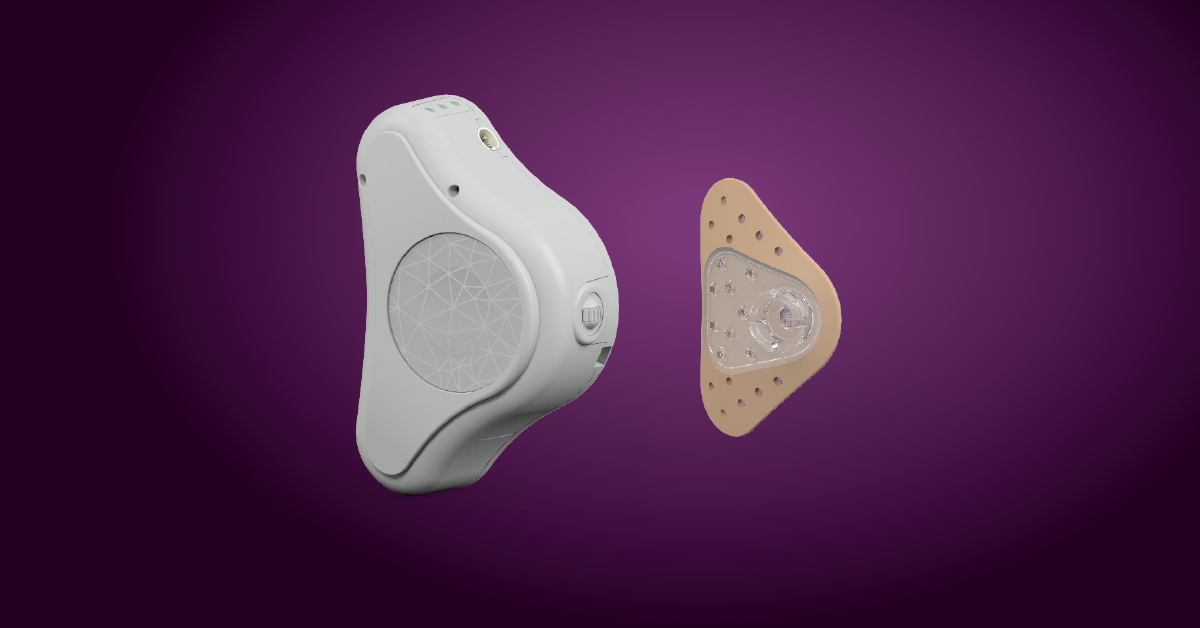ADHEAR System offers Clinicians Flexibility to Effectively Manage Conductive Hearing Losses during COVID-19

Audiology Online: COVID-19 introduced unprecedented challenges for audiologists, many of which we are still grappling with. What has MED-EL Corporation done in recent months to support patients, candidates and centers?
Amanda O'Donnell: It has been a whirlwind few months. We are a global company with thousands of employees, centers and recipients to support. The onset of COVID-19 was a shock to us all. We focused on priorities – our recipients and professional partners - and sped up our journey toward effective remote support so that we could provide uninterrupted service to our recipients and the professionals working with our products.
Audiology Online: Can you provide any examples of how MED-EL has innovated in its support for professionals?
Amanda O'Donnell: Certainly. In about the 3rd week of March it became clear that COVID-19 would have a major impact. I’m an audiologist, and while it was clear to me and the team that many surgeries, such as cochlear implant and bone conduction implant surgeries, would by necessity be placed on hold for an indeterminate period of time, it was also clear that this would leave many already-identified candidates with conductive hearing loss without treatment, even little ones in the critical language learning months and years whose only option is a non-surgical bone conduction system. Families all over the country saw a sudden disruption to their plan of care – surgical or non-surgical. Clinics shut down, elective surgeries were

cancelled or postponed. Audiologists were suddenly working from home, furloughed or reassigned to emergency response. We worked with MED-EL’s Regulatory Affairs group and the FDA to obtain an enforcement discretion that affords us the ability to offer the ADHEAR COVID-19 Program which has two major components: flexible shipping and support for remote orientations. We are grateful to the FDA for having reviewed our request and we are confident that it is a positive offering for candidates and professionals. You can learn more about the ADHEAR COVID-19 program here.
AudiologyOnline: How does this work? When does the ADHEAR get programmed and what do you mean by flexible shipping?
Amanda O'Donnell: As Product Manager for our bone conduction systems, I immediately recognized that ADHEAR has unique characteristics that could potentially allow audiologists to continue serving identified candidates during this unprecedented time.
First – it’s a non-surgical system that is pressure-free and comfortable. It’s suitable for all ages and stages. Second – and this is critical – it ships pre-programmed for the candidacy range and has been shown to provide equivalent performance to other non-surgical bone conduction devices. In fact, the software has always been described as an optional configuration software.
We have learned in the two years since launching ADHEAR that the most important aspect of success and satisfactory outcomes is training the user or caregiver. A thorough orientation including practice with handling the adhesive adapters and the audio processor is a critical part of the process.
Given the public health emergency, we proposed to the FDA that we could offer audiologists flexible shipping to either the clinic or direct to the patient’s door, so that social distancing or lockdowns could be handled. In addition, we proposed that we would provide professional follow-up from our clinical support team where needed, to assist audiologists in preparing for and providing a remote orientation. The FDA approved the enforcement discretion which we have offered since late March.
We also provide a range of additional supports to the audiologist including a device orientation checklist, a follow-up use and satisfaction questionnaire, use and care videos, a systematic review of the literature1 and if schedule allows and the audiologist wishes, one of our team members can even attend the remote orientation video call with the clinician and family. Since many families have access to a computer or cellphone there is usually some type of video call option that will work for everyone involved.
AudiologyOnline: How have audiologists responded to the ADHEAR COVID-19 Program?
Amanda O'Donnell: The response has been overwhelmingly positive. The program, which we can offer for the duration of the pandemic, is supportive of candidates and audiologists. It is reflective of our need to find new ways to move forward during this time. We simply cannot put hearing on hold until we get back to normal.
I recommend all audiologists take into consideration that even as we see things gradually improve and risk levels reduce, some families will need remote care appointments for longer than others until they are confident getting out in public again. Some individuals who need bone conduction systems have complex medical conditions and may be in a high-risk category. The ADHEAR COVID-19 Program allows professionals to be flexible in how they handle these differing comfort levels.
AudiologyOnline: Is there anything else you would like to add about the ADHEAR COVID-19 Program?
Amanda O'Donnell: I should also mention, that as ADHEAR is a prescription device, MED-EL strongly recommends that all recipients follow up with an in-person appointment once it is safe to do so, at which time minor programming adjustments may be made by the audiologist if needed. If, in the meantime, the recipient is having any difficulties with ADHEAR or the telecare model they should reach out to their audiologist for assistance.
AudiologyOnline: I’m fascinated that ADHEAR comes preprogrammed and the COVID-19 ADHEAR Program sounds very useful. Are there any particular groups that you see it impacting during the pandemic?
Amanda O'Donnell: The first obvious one is children who are in their language-learning years. Ensuring access to sound is the goal of every audiologist. Anyone who is identified as a potential candidate probably should be made aware of ADHEAR as an option. There’s one group, however, that we don’t always think of for bone conduction devices and that is the higher risk groups with conductive hearing losses of chronic but uncertain duration. Recurrent ear infections and Otitis Media with Effusion (OME) is highly prevalent in children with cleft conditions, Down Syndrome and other craniofacial conditions. We have seen some centers really take to ADHEAR for these groups with chronic conductive hearing losses and fluctuating air-bone-gaps. Interested readers may wish to take Course #34739 on AudiologyOnline. Rachel Sharnetzka, Au.D., of the Lancaster Cleft Palate Clinic joined Lynn Stephenson of MED-EL to review her experiences with the use of ADHEAR for children with conductive hearing loss and craniofacial differences.
What do we know about their hearing technology options for individuals with chronic conductive hearing losses of uncertain duration?
- We know that air conduction hearing aids in these groups are not optimal because the air-bone gap fluctuates and therefore gain adjustments are frequently needed.
- Air conduction hearing aids may not be comfortable with masks in the current pandemic situation.
- Pressure-based systems, using softbands or other coupling can be uncomfortable and result in low usage time.
- Most devices need to be programmed and do not readily support social distancing.
Flexible shipping and remote orientation support social distancing. The affected child will have consistent sound input throughout the day, regardless of fluctuations in the air-bone-gap and the off the ear placement is compatible with most facial coverings such as masks. ADHEAR is a proven, non-invasive way to handle these chronic conductive losses.
AudiologyOnline: Before we wrap up, what do we know about children and ADHEAR? Have there been any studies looking at outcomes, performance or subjective satisfaction?
Amanda O'Donnell: MED-EL has been gratified by the level of scientific interest we have seen in ADHEAR since its launch in 2018. Quite a large body of publications has emerged on ADHEAR in just two short years. The results of these publications are summarized below and are discussed and visualized in the review authored by Postert, Kiesewetter and Dejaco (2019). A link is provided below.
Key findings (weighted means) from the pediatric publications:
- Aided soundfield threshold (PTA4) of 27.6dB HL
- Functional gain: 27.3dB
- Word recognition score in quiet of 92.8%
- Improvement: 65.3%
- Aided SRT50 in noise: -3.3 dB SNR
Because the subjective aspect of hearing technology should never be dismissed, I would also like to share a couple of quotes from pediatric cohort studies. Neumann et al (2019) looked at ADHEAR in a group of children with conductive hearing loss under the age of ten. Nine of eleven participants continued to use ADHEAR after study completion:
“Patients and parents both demonstrated high levels of satisfaction with the device, especially in relation to the fact that it overcomes many of the pressure-related limitations of softband-integrated bone conduction systems and because the device is cosmetically appealing with no or only minor stigmatization. Most patients continued to use the adhesive device after the end of the study”
In the publication by Osborne et al (2019):
“Self-confidence in 18 [out of 21] of participants was increased following the use of the adhesive system.
Following the closure of this study, all children requested to continue with the use of the adhesive retained BC system and to date none have returned to their previous bone conduction hearing aids.” P. 8
And,
“The resultant impact of its use has shown a significant improvement in patient’s QOL with children preferring this form of hearing system to the traditional softbands.” P. 9
AudiologyOnline: Thank you! I enjoyed this discussion and it’s always interesting to hear of innovative ways of ensuring the patients we serve get the interventions they need.
Amanda O'Donnell: My pleasure. If readers are interested and have not already gotten started with ADHEAR or the ADHEAR COVID-19 Program, they may reach out to MED-EL via their local clinical representative, via MED-EL directly at 1-888-633-3524 or via the ADHEAR COVID-19 Program page at https://hearlife.medel.com/en-us/local/us-pages/adhear-covid-19-program
- Postert, B., Kiesewetter, K., Dejaco, T. (2019) The ADHEAR System – Review of clinical evidence and user satisfaction. Revision 1.0. White Paper. MED-EL: https://medel.showpad.com/share/eo4aAUuU09Te8G4ReejWW/0
- ADHEAR COVID-19 Program.URL: medeladhear.com
- Osborne MS, Child-Hymas A, Gill J, Lloyd MS, McDermott AL. First Pediatric Experience with a Novel, Adhesive Adapter Retained, Bone Conduction Hearing Aid System. Otol Neurotol. 2019;40(9):1199-1207.
- Neumann K, Thomas JP, Voelter C, Dazert S. A new adhesive bone conduction hearing system effectively treats conductive hearing loss in children. Int J Pediatr Otorhinolaryngol. 2019;122:117-125.


